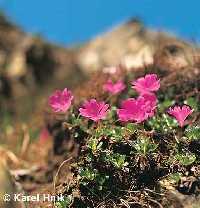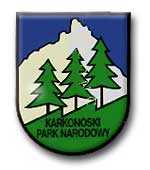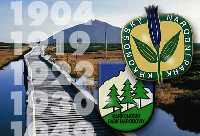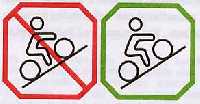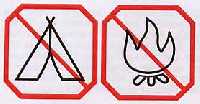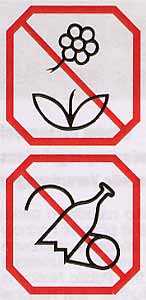
©2008 Mediapool
|

Nature conservation in the Krkonose Mts.
Many visitors don’t perceive that the nature in the Giant Mountains is in a state of serious endangerment. Paradoxically, while prestigious international institutions (Dutch foundation FACE, European Union, UNECSO, The World Bank) help to rescue the valuable nature of the Giant Mountains, we ourselves continually destroy it. The worst menaces of today are not only pollutants but also unregulated invasion of tourism.
You can also contribute to this effort to preserve the nature of the Giant Mountains for future generations by following the visitor regulations of the parks, signs and information boards.
MaB, KRNAP, KPN
History of conservation
Visitor regulations
 Nature
 Shown as list
(found: 7 out of 95 records in category: Nature)
Ergis #ID: 34

KRNAP
Krkonošský národní park - KRNAP (Giant Mountain National Park in the Czech Republic) was founded in 1963 as the first national park in the Czech Republic. It covers an area of 370 km2 (570 km2 with a protective zone). It divides into three zones according to the level of preservation - I and II are the most strictly protected zones.
In the area of the park visitors can find many information and tourist centres as well as several thematic exhibitions.
Management of KRNAP is responsible for the preservation of the Giant Mountain nature. This covers mainly regeneration of natural forests, preservation of endangered plant and animal species as well as a range of watch, research, information and cultural activities. The management is not responsible for visitors' security - this is a duty of Rescue Organisation.
KRNAP management
Tourist centres
Ergis #ID: 35

KPN
Karkonoski Park Narodowy - KPN (Giant Mountain National Park in Poland) was founded in 1959 and covers an area of 55 km2.
In the area of the park visitors can find many information and tourist centres as well as several thematic exhibitions.
Management of KPN is responsible for the preservation of the Giant Mountain nature. It is not responsible for visitors' security - this is a duty of Rescue Organisation.
KPN management
Ergis #ID: 36

MaB
In 1992 the Giant Mountains (KRNAP and KPN areas) were incorporated into an international network of biospheric reservations. Biospheric reservations are nominated and enunciated by the world organization UNESCO in the frame of MaB project (Man and Biosphere). These are the most valuable and endangered areas of the world, which are significant for the preservation of the natural wealth and ecological equilibrium on the Earth. The Giant Mountains joined Amazon primeval forests, African Serenghetti savannahs and others in the network. This way UNESCO gains an opportunity to set rules of the preservation of these areas and supports them financially. The biosheric reservation of Krkonoše-Karkonosze (The Giant Mountains) divides into three zones according to the level of preservation: core (contains I and II zones of KRNAP), buffer and transition zones.
Ergis #ID: 37

History of conservation
1904– Earl J. Harrach established the first natural park in Labský pit
1919– the first Czechoslovak notice of the Giant Mountain flora conservation
1922– establishment of the natural park in Malá Sněžná Jáma in Poland
1923– professor Schustler offered a proposal to establish a national park of the Giant Mountains and Jizerské hory
1930– establishment of Kotelská rokle natural park
1949-1959– establisment of 6 natural parks in Poland
1959– establishment of Krkonošský (the Giant Mountains) National Park (KNP) on the Polish side
1963– establishment of Krkonošský (the Giant Mountains) National Park (KRNAP) on the Czech side
1983– initiation of the project of the preservation of genetic resources of the Giant Mountains
1993– selected peat moors of the Giant Mountains are included in the list of Ramsar Convention on Wetlands of International Importance
1993 – initiation of the project of the regeneration of the forests in the Giant Mountains in co-operation with Duth foundation FACE
Ergis #ID: 42

Zones in the Krkonose National Park
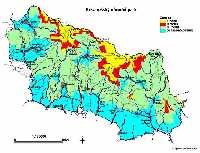 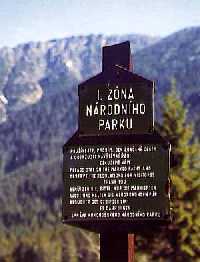
The territory of Krkonose National Park is divided into four categories according to quality and haleness of living environment: 1st zone, 2nd zone, 3rd zone and protective zone.
The 1st zone includes territories with the most significant natural values as follows: the crest regions, iceberg corries, forests and greenfields with high species variety as well as the significant geological formations. Basically continuous, these territories are complemented with certain enclaves such as Cernohorske raseliniste peat bog, Albericke lomy quaries, Rychorska kvetnice and the primeaval forest etc. Besides, one can see in these places the glacial relicts, i.e. species, which are the witnesses to the last ice-age, peat-bog, and the landscape, which is by no means incidentally similar to that of northern tundra. Those seen here are also the results of a long-standing incidence of ice, snow, water and wind on the earth surface – the characteristic granite rocky formations, polygonal soils, corries, terrestrial landslips, endemic species and subspecies, e.g. the hawkweeds, Sudetic Rowan, Bohemian Bellflower etc. Known from the animal species are the snail Cochlodina dubiosa corcontica, and mayfly Rhithrogena corcontica etc.
With more or less broad protective belt, the 2nd zone is previewed to encircle the 1st one. Inherent here of are territories with significant natural values along the upper forest margins and predominantly man’s modified sylvan and meadow-based ecological systems beingsuitable for a limited and parsimonios sylvi-or-agricultural exploitation. This is where you can encounter either the foresters or nature protection field-workers under way of their regulative and curative activity in protecting certain rare species or renewing, e.g. the original composition of vegetation etc. One can see also grazing cattle and an experimental pasturage of sheep.
The 3rd zone comprises the „remainder“ of the KRNAP-protected territory. Why it is in inverted commas is that this territory is concerned 3-times bigger than that of the 1st and 2nd zones altogether. This region faces an intensive both recreational and tourist-related exploitation. In addition, the non-forest soils are loaded here with agricultural production, in particular, the pasturage and haymaking, all in respecting the specific protection scopes of biological variety on the protected territory.
Being not only a proper component of the KRNAP territory, the protective zone in question forms a sort of protective belt to assure the whole park's territory against the spurious impacts. Here we shall find the principal recreational and sport centers such as Harrachov, Spindleruv Mlyn, Pec pod Snezkou and Velka Upa. Here is under way an intensive agricultural activity, namely, the beef raising. Suitable conditions are also available for manufacturing the eco-products.
Ergis #ID: 33

Nature conservation in the Krkonose Mts.
Many visitors don’t perceive that the nature in the Giant Mountains is in a state of serious endangerment. Paradoxically, while prestigious international institutions (Dutch foundation FACE, European Union, UNECSO, The World Bank) help to rescue the valuable nature of the Giant Mountains, we ourselves continually destroy it. The worst menaces of today are not only pollutants but also unregulated invasion of tourism.
You can also contribute to this effort to preserve the nature of the Giant Mountains for future generations by following the visitor regulations of the parks, signs and information boards.
MaB, KRNAP, KPN
History of conservation
Visitor regulations
Ergis #ID: 46

The rules of visits to The Krkonoše National Park
ARTICLE 1
Introductory regulations
1) The purpose of this Public Notice is securing the functions of the Krkonoše National Park (further just National Park) given by its mission to protect the natural values of the area for pertaining its stabile ecosystems, and, in addition, for scientific, educational and enlightening use. Especially it takes care of directing the regime of the tourist and recreational activities in the National Park.
2) The Rules of Visits is a generally obligatory legal regulation. Its effect includes all the physical and legal persons present in the area of the Park or carrying there out their activities. The consent with a different regime of behaviour is granted by the Administration of the National Park (further just Administration).
ARTICLE 2
Prohibition and limits to some activities
1) In all the area of the National Park it is forbidden
a) to enter the areas with newly-planted vegetation done to support the wood restoration
b) to enter caves and other underground spaces
c) to scare and catch wild animals
d) to pick wild plants or their parts except fruits of forest plants
e) to throw away rubbish, to litter or damage springs and waterways
f) to manipulate or damage the equipment for tourism and recreation located in terrain like tourist marking, information boards, rest places, view-points and other generally useful facilities
g) to let dogs run free
h) to behave in a way that could cause damage to the environment and which is in contradiction to the mission of the National Park, esp. to disturb the quiet by excessive noise etc.
i) to organize group sporting, tourist and other actions
j) to install removable ski-lifts and mark winter cross-country and down-hill skiing tracks and both summer and winter tourist tracks
k) to camp and to make fires
l) to ride horses and organize dog-team rides
m) to practise water sports except the Jizera river and upper reach of the Labe river (reach Labská Dam–Kukačka)
2) The Administration can, in designated areas or certain times give consent to activities listed under i), j), k), l) and m) of paragraph 1). The actions carried out on regular attested XC or DH ski tracks are not considered activities listed under the letter i). These, however, must be announced at the Administration beforehand.
3)In winter the access to hunters’ facilities for feeding the animals and to winter-support areas is forbidden with the exception of marked tourist paths.
4) In the areas of zone I and zone II of the National Park besides the activities listed in paragraph 1) it is also forbidden to pick the fruits of forest plants and to enter areas outside marked tourist paths, or, in winter, outside the pole-marked paths, including ski-alpinism.
5) In case of insufficient snow cover it is obligatory for the visitors to respect the closed-down parts of pole marking having been closed by the Administration for the purpose of nature protection.
6) The conditions of car entry, stay and driving in the area of the National Park including the fees are determined by the Public Notice No 2/1995 of the Administration and the persons within the boundaries of the Park shall abide by them.
ARTICLE 3
Mountain Cycling
It is forbidden to practise cycling in the Park outside roads, local communications and paths designated for that purpose with the consent of the Administration. The paths for mountain cycling and the conditions of their operation are determined in a special decision of the Administration
ARTICLE 4
Mountaineering and flying
In the area of the National Park it is forbidden to practise mountaineering with the exception of following parts:
– Hnědé skály rocks (k. ú. Strážné, p. p. č. 1958/1)
– Hranostají skála rock (k. ú. Strážné p. p. č. 1892)
– Emin kámen stone (k. ú. Labská, p. p. č. 103/16, 17)
– Lubošské skály rocks (k. ú. Harrachov, p. p. č. 1033/36).
All the nature components of the mountaineering terrains will receive maximum protection
2) Paragliding and hang-gliding are forbidden in all the area of the Park with the exception of the operation parts of the delimited flight corridors determinated by independent decision of The Administration. Operating areas are marked by signboards with obligatory signs.
ARTICLE 4a
Water sports
1) It is possible to do water sports – run down the Jizera river and upper reach of the Labe river (reach Labská Dam–Kukačka) on the crafts without an engine.
2) To aboard and get off the craft is possible only on determinated places. Those places and their entrances are marked with signboards.
3) To do water sports on the Labe river is possible only under permission of The Administration. Floating time of the day is from 8AM till 6PM. Terrain Service Center of the Administration in Špindlerův Mlýn emits the permission with other floating conditions.
ARTICLE 5
Information, educational and enlightening activities
The protection of nature, the educational and enlightening use of the National Park are directed and organized by the Administration. For these purposes there are information centres established in Pec pod Sněžkou, Špindlerův Mlýn, Vrchlabí, Harrachov and Rokytnice nad Jizerou. While organizing this activity the Administration cooperate with the municipal and local authorities. The above listed centres provide information about closed-down ways (art. 2, par. 5), the cyclotouring tracks (art. 3) etc.
ARTICLE 6
The guards of nature, fines
1)The inspection over keeping the rules within this Public Notice and other generally obligatory legal regulations is carried out by the guards of nature of the Administration. After showing their service-card, the guards are entitled to:
a) determine the identity of persons infringing the regulations in the sphere of nature protection
b) impose and collect the block fines up to 1000 Kč
c) stop the infringing activity if its continuation should endanger the nature immediately
d) detain a suspicious person who is found to be breaching legal regulations regarding nature and country for identification and hand that person over to the Czech Republic Police Authority; caught persons are obliged to obey
e) ask for help or co-operation of the Czech Republic Police Authority possibly municipal police if meeting their obligations cannot be ensured through their own powers and means
2) Trespassing the regulations within the Public Notice can be fined by the Administration in the case of physical person up to 10 000 Kč; the legal as well as physical persons undertaking business activities can be fined up to 500 000 Kč
ARTICLE 7
Transient, general and final regulations
1) The entrance prohibition under art. 2, par. 4 does not concern the owners and tenants of the land
2) For the purpose of this Public Notice winter period is meant within December 15 and March 15
3) The effect of this Public Notice as amended starts on April 15, 1993
|
Our tip
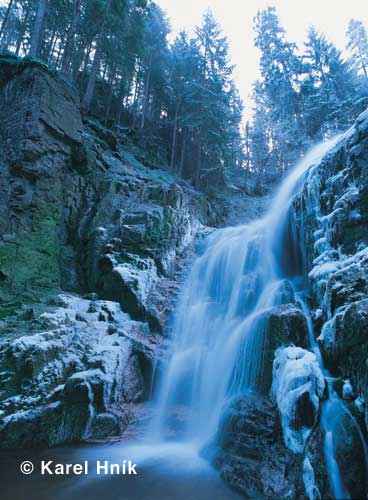
Our tip
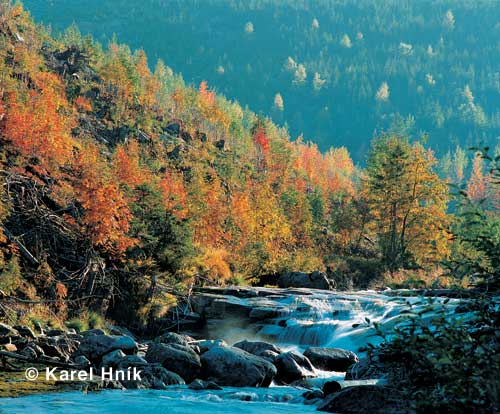 Špindlerův Mlýn
Špindlerův Mlýn
Our tip
 Špindlerův Mlýn
Špindlerův Mlýn
|



